What is PPC in marketing? A Starter Guide to Pay-Per-Click Marketing
Feeling lost in the world of online advertising? Heard of “PPC” but not sure what it actually means or how it works? You’re not alone. PPC in marketing, short for Pay-Per-Click, is one of the most popular and effective digital advertising models, yet it often sounds more complicated than it is.
Simply put, PPC is a strategy where businesses pay only when someone clicks on their ad. It’s a fast-track way to drive targeted traffic, generate leads, and boost sales. Whether you’re a small business owner or managing a growing brand, PPC offers control, precision, and measurable results.
Why does it matter? Because PPC works. According to a 2023 study by Google, businesses earn an average of $2 for every $1 spent on Google Ads. It proves just how powerful this channel can be when used correctly.
By the end of this guide, you’ll understand what PPC is, how it works, the key platforms, and how to get started with your first campaign. Let’s break down the jargon and make PPC marketing simple, strategic, and actionable.
What is PPC in Marketing?
PPC, or Pay-Per-Click, is a type of digital advertising where advertisers pay only when someone actually clicks on their ad, not when it’s simply shown. It’s like buying traffic to your website instead of waiting for it to come organically.
Think of it as paying for a lead rather than just renting space on a billboard that people may or may not notice.
This model is different from traditional advertising (like TV or print), where you pay for exposure, not engagement. Even compared to display ads sold by impressions (CPM), PPC gives you more control and better performance tracking.
The most common example of PPC in action? Google Ads. When you search for something like “best running shoes,” the top results often include ads from those businesses that are using PPC to appear there.
PPC is popular because it offers instant visibility, laser-focused targeting, and a measurable return on investment, ideal for businesses that want results, fast.
PPC vs SEO vs SEM: What’s the Difference?
When diving into PPC in digital marketing, it’s easy to get confused by related terms like SEO and SEM. Here’s a quick breakdown:
- SEO (Search Engine Optimization) is all about earning traffic naturally by optimizing your website and content so it ranks high in search engines over time. It’s free to click, but it takes time and consistent effort to see results.
- PPC, on the other hand, is paid advertising, like display ads or search ads, where you pay each time someone clicks. It delivers fast, targeted traffic, making it ideal for time-sensitive campaigns or quick visibility.
- SEM (Search Engine Marketing) is the umbrella term that includes both SEO and PPC. It refers to any strategy that helps you appear in search engine results, whether organically (SEO) or through paid methods (PPC).
Using SEO and PPC together can be a powerful combo while SEO builds long-term authority, PPC gives you immediate reach. A balanced strategy lets you dominate search results from both angles.
But there are some significant differences between SEO and PPC, like:
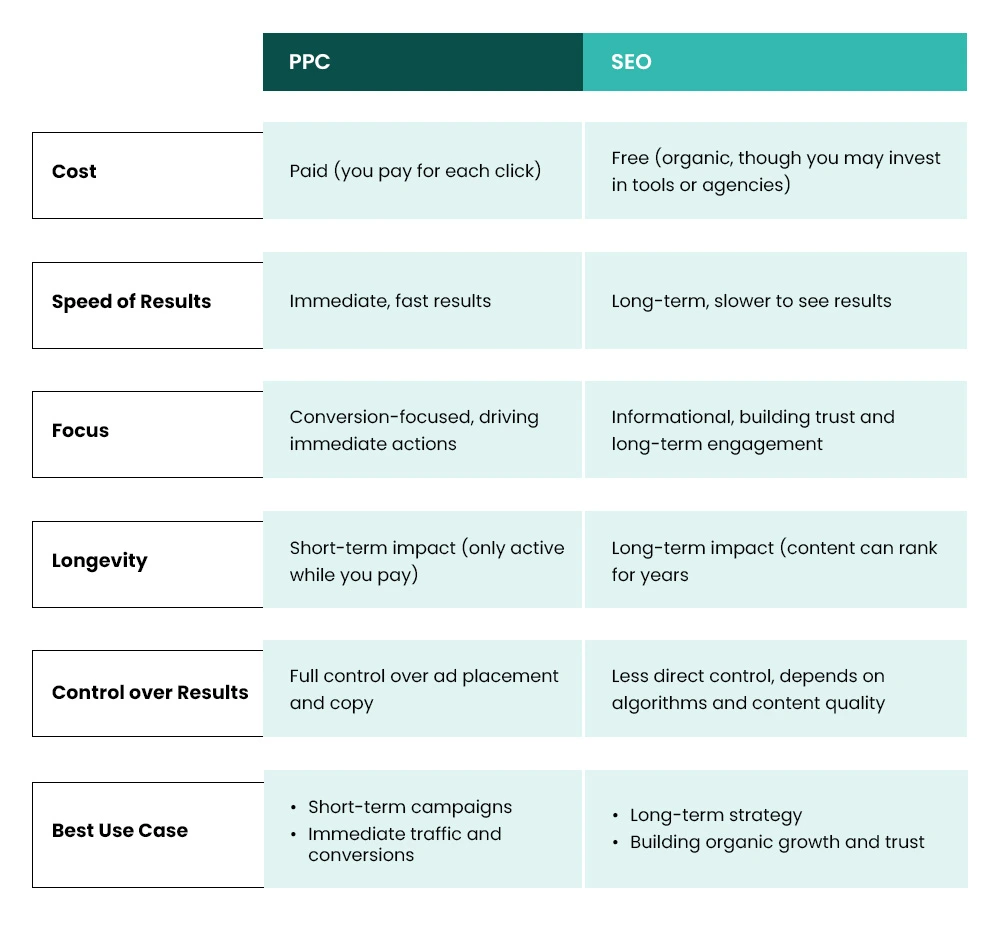
Types of PPC in Marketing
You have a variety of choices when it comes to running a PPC campaign that can vary by platform. Here are some of them:
a) Search Ads
Search ads are text-based PPC ads that appear on search engines like Google and Bing when someone types in a relevant query. These ads typically show up at the top or bottom of the search engine results page (SERP) and are marked with labels like “Sponsored” or “Ad.”
For example, if you search for “best project management platform,” you’ll likely see ads from software companies competing for your click.
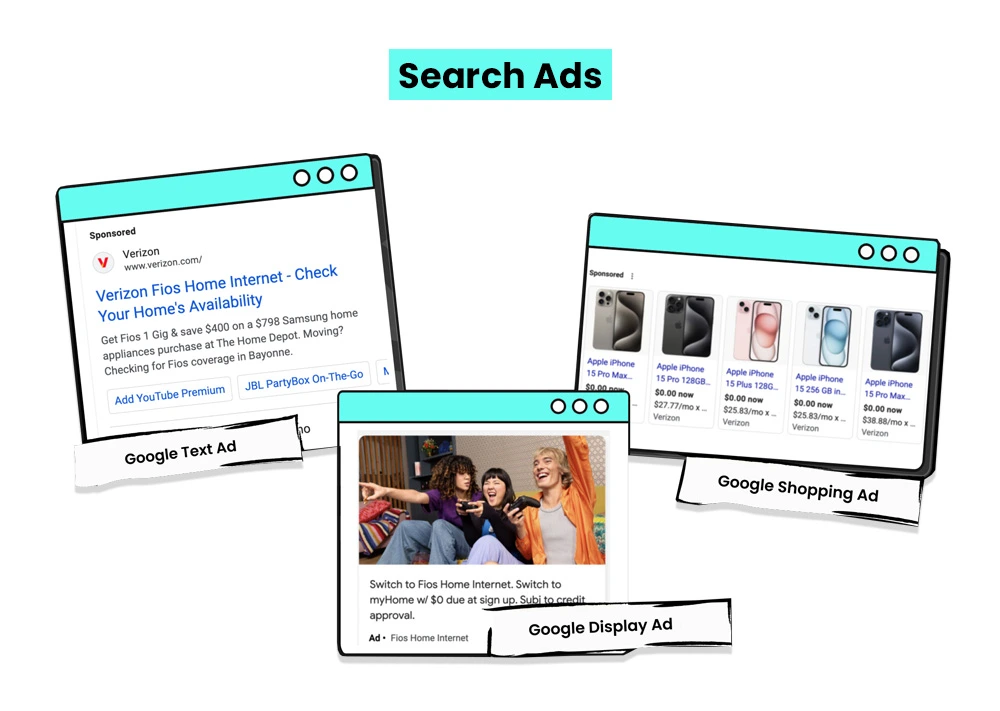
The biggest advantage? Search ads offer instant visibility to users who are actively looking for products or services like yours. It will make them one of the most effective forms of PPC advertising for capturing high-intent traffic.
b) Display Ads
Display ads are visually driven ads, typically in the form of banners, images, or rich media. They’re most commonly run through Google Ads and appear across a wide range of websites, apps, and platforms within the Google Display Network (GDN) and its partner sites.
Unlike search ads that show up in response to a specific query, display ads are shown based on factors like users’ browsing behavior, interests, demographics, or custom audience targeting set by the advertiser.
For example, you might see a display ad on a site like Forbes after browsing for similar products or services elsewhere.
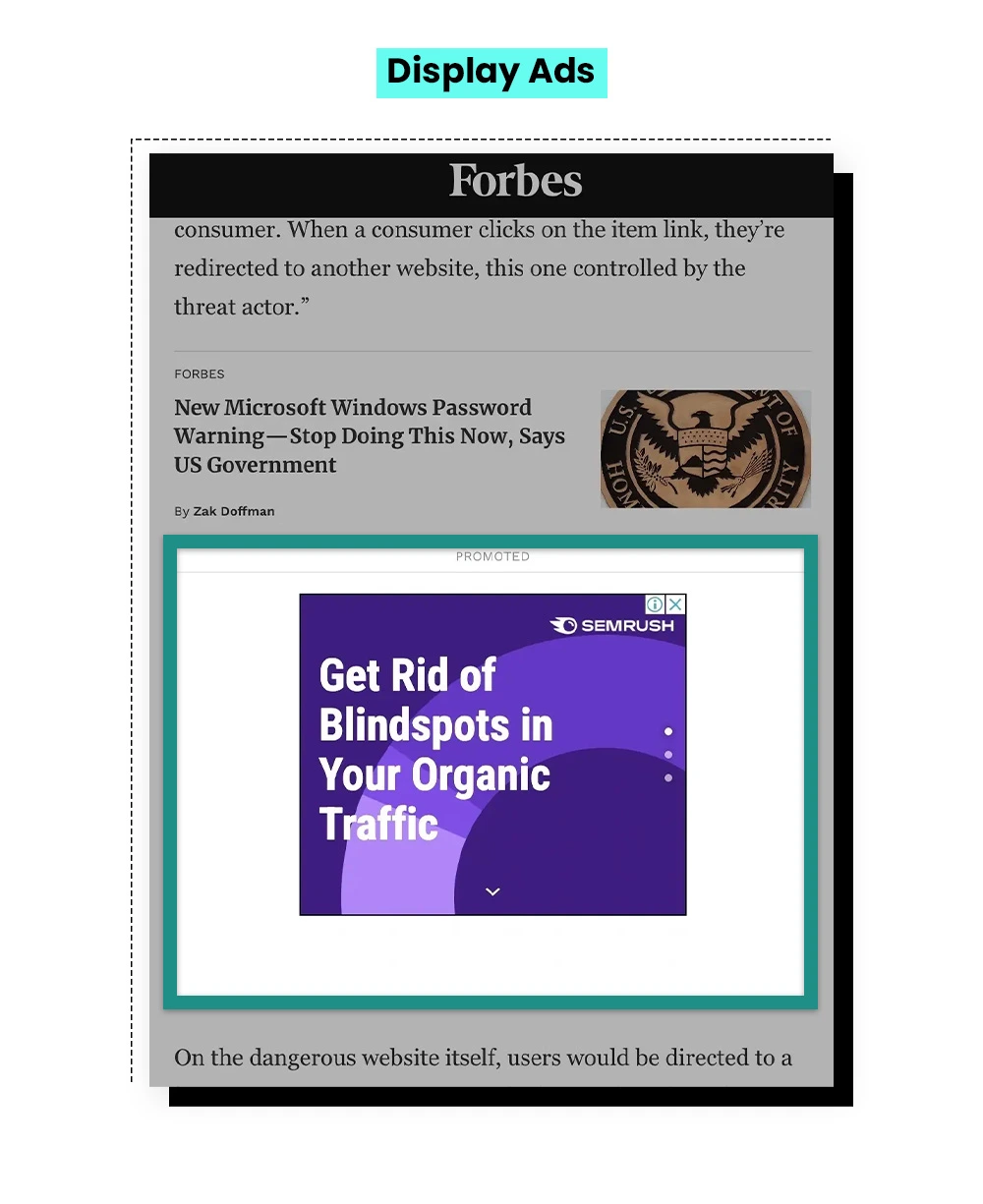
c) Shopping Ads
Shopping ads are image-based product listings that appear in Google search results and the Shopping tab. These ad campaigns are ideal for eCommerce brands, as they reach users actively searching for specific products, boosting visibility and purchase intent.
For example, here’s what users might see if they search for standing desks:
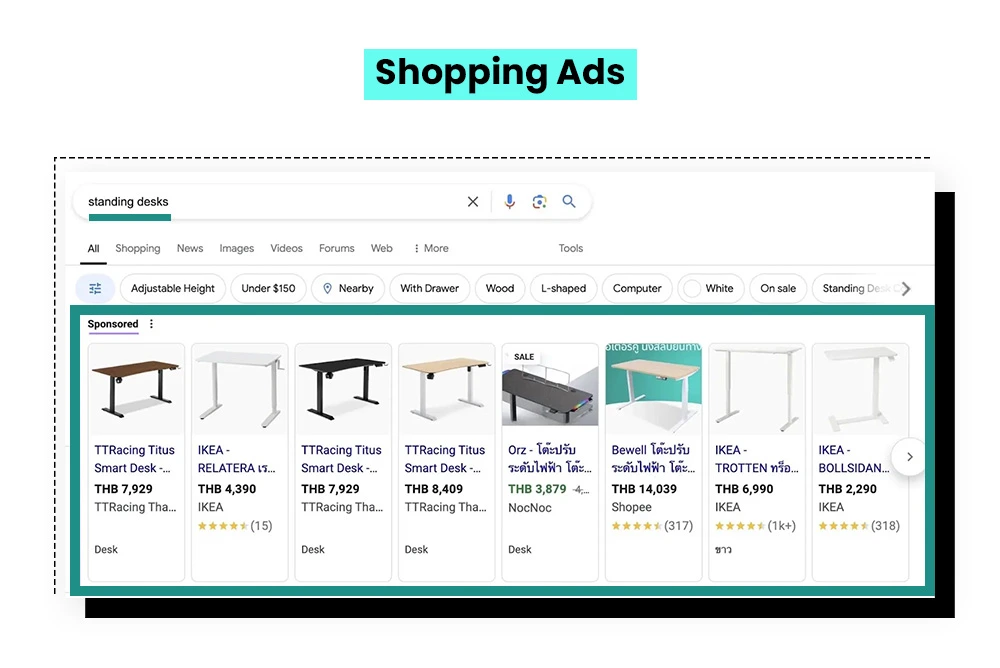
d) Retargeting Ads
Retargeting ads (also known as remarketing ads in Google) are shown to users who’ve previously visited your website or engaged with your content but didn’t take an action.
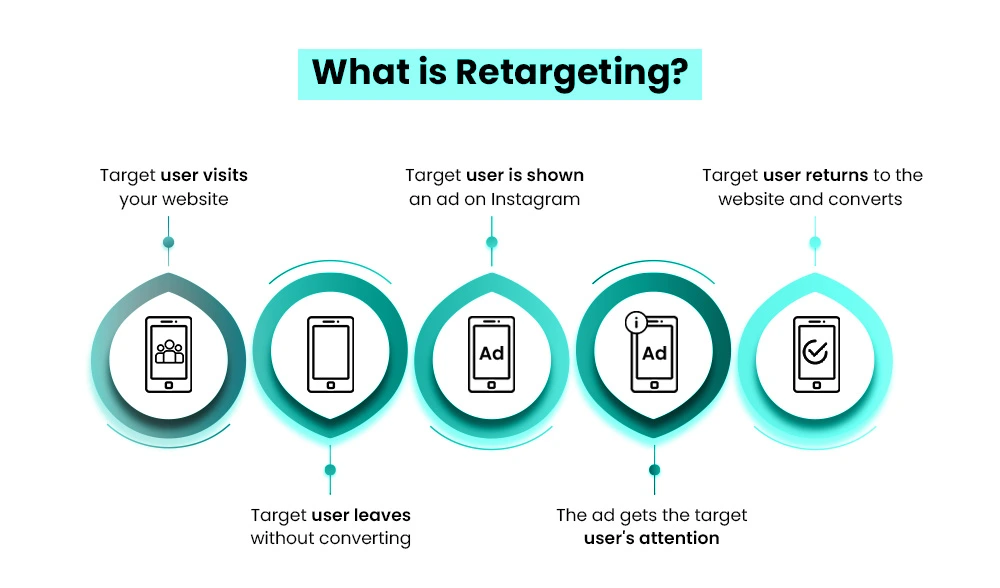
For example, if someone browses your online store, adds a pair of shoes to their cart, but leaves without buying. You can launch a PPC ad to remind them of that exact product across other sites or platforms.
These ads are highly effective for bringing users back, boosting engagement, and increasing conversions by keeping your brand top-of-mind.
– Also Read- 7 Proven Ad Retargeting Strategies to Optimize Your Campaign Performance
e) Video Ads
Video ads run across platforms like YouTube, LinkedIn, Instagram, and other sites across the web. They’re especially effective for storytelling or conveying complex messages in a more engaging, visual format that captures attention and builds stronger brand connections.
Benefits of PPC in Marketing
PPC shouldn’t be considered a marketing expense instead, it is an asset. PPC in digital marketing provides numerous benefits, some of which are listed below:
1. Targeted Audience
PPC advertising lets marketers target by demographics, interests, behaviors, and location, ensuring your ads reach the right people. Platforms like Facebook go even further, helping you connect with users most likely to convert.
Instead of broad exposure, you get precise targeting that drives real results. It’s a smarter, more efficient way to turn clicks into customers.
2. Segmented Breakdown
Pay-per-click advertising offers powerful segmentation not just in targeting, but also in reporting. Advertisers can break down performance data, like comparing mobile vs. desktop conversions.
If the desktop shows a higher conversion rate, they can adjust bids to prioritize that channel. This insight-driven approach helps optimize ROI and ensures smarter ad spending across platforms.
3. Provides Higher ROI
One of the biggest advantages of pay per click advertising is that you only pay when someone shows real interest by clicking your ad. This means your budget is spent on users who are already considering your offer.
When someone clicks, they’re directed to a dedicated landing page, designed to guide them toward a specific action; whether it’s making a purchase, signing up, or learning more. A well-crafted landing page plays a crucial role in converting interest into action by delivering relevant information and a clear next step.
This focused experience boosts ROI by aligning ad spend with actual user engagement.
4. Boosts Online Visibility
PPC advertising is a powerful way to boost brand awareness, drive quality leads to your website, and increase conversions. It gives you full control over where your ads appear, allowing precise targeting based on audience behavior, interests, and location. With the flexibility to reach your most valuable prospects, PPC helps maximize your marketing impact and return on investment.
5. Enhance Other Marketing Efforts
Paid search marketing is less affected by algorithm updates that often disrupt SEO strategies, making it a more stable option for visibility, even with a low domain rating. Plus, the insights gained from PPC campaigns, especially keyword data, can significantly enhance your overall search engine marketing efforts and drive smarter, more effective SEO optimizations.
How Does PPC Work?
PPC in marketing works through an auction-based bidding system that decides which ads appear when someone searches online. But unlike a traditional auction, winning isn’t just about bidding the most money.
Here’s a simple breakdown of how it works:
- You choose keywords you want your ad to show up for (e.g., “best running shoes”).
- You set a bid, which is the maximum amount you’re willing to pay when someone clicks your ad.
- Your ad enters an auction every time someone types a relevant query into a search engine.
- Google (or another platform) decides where and if your ad appears based on your bid and your ad’s quality score. It is a combination of your ad’s relevance, landing page experience, and expected click-through rate.
- You only pay when someone actually clicks your ad, making every dollar of your advertisement campaign count.
For example:
If you’re running a Google Ads campaign for a new fitness app and someone searches “best home workout apps,” your ad enters the auction. If your bid is competitive and your ad has a high quality score, your ad will appear near the top of the search results.
PPC in marketing helps you reach the right people at the right time, without wasting your budget on empty impressions.
What are the Common PPC Platforms?
Several top platforms offer PPC advertising solutions, with Google, Microsoft Bing, and Meta leading the way.
Each platform supports different ad formats, ranging from search and display ads to remarketing and video content. Whether it’s YouTube pre-rolls or Instagram Reels, the type of platform you choose will influence how your ads are shown and how effectively they reach your target audience.
Here are some of the most famous PPC platforms:
1. Google Ads
Google Ads is the largest PPC platform, holding 39% of the market share. It allows you to run ads across the full Google Network, including:
- Google search results pages
- Google-owned platforms like YouTube and Google Maps
- Over 35 million third-party websites and apps within the Google Display Network (GDN)
There are six types of Google Ads campaigns, including search, display, shopping, and video. With Google Ads, you can target users most likely to convert by bidding on specific keywords, ensuring your ads appear in relevant search results.
You can also refine your audience targeting by focusing on segments, groups of users with shared characteristics or behaviors, to reach the people who matter most to your business.
– Also Read- 5 Effective Tips to Optimize Your Google Ads Campaigns for Better Conversions
2. Meta Ads
Meta Ads Manager is a powerful online advertising platform that lets you run PPC ads across Facebook and Instagram. It supports various ad formats, including image, video, and carousel ads, allowing users to swipe through multiple visuals in a single ad.
With highly specific targeting options based on demographics, interests, and behaviors, Meta helps brands reach audiences who are most likely to engage and convert. This will make every ad spend more efficient.
3. Microsoft/Bing Ads
Microsoft Advertising, formerly Bing Ads, is a robust platform that lets businesses run ads on the Bing search engine and across the Microsoft Advertising Network. This includes a wide range of partner websites and apps.
Advertisers can create various ad types—search, shopping, product, display, and video to reach specific audiences based on demographics, interests, and behaviors. Campaigns can be purchased on a pay-per-click (PPC) or pay-per-impression basis, allowing businesses to pay only when users engage with or view their ads.
4. YouTube Ads
YouTube ads are a powerful form of online advertising that let businesses promote their products or services directly on the YouTube platform. These ads come in several formats, including:
- Skippable video ads: Viewers can skip these after five seconds. They can run up to 60 seconds in length.
- Non-skippable video ads: These must be watched in full before the main video plays and are typically 15 seconds long.
- Bumper ads: Short, non-skippable ads lasting six seconds or less.
- Sponsored cards: Small interactive elements that appear during videos and provide additional product or service info.
- Overlay ads: Semi-transparent banners that display at the bottom of a video.
Advertisers can precisely target audiences based on demographics, interests, and user behavior. YouTube ads are flexible in pricing, typically using either a cost per view (CPV) or cost per click (CPC) model.
With CPC, advertisers only pay when a viewer clicks on the ad, making it a budget-efficient way to drive engagement and reach highly relevant audiences.
5. LinkedIn Ads
LinkedIn, owned by Microsoft, offers a variety of ad formats designed to reach professional audiences effectively. These include:
- Sponsored Content: These native ads appear in users’ newsfeeds and can be text, image, or video-based, blending seamlessly with organic content.
- Sponsored InMail: Delivered directly to users’ inboxes, these ads feel more personal and drive engagement.
- Sponsored Jobs: Highlight job openings at the top of LinkedIn’s job section for increased visibility.
- Display Ads: Banner ads that appear on the right side of the platform, great for brand awareness.
- Dynamic Ads: Automatically personalized for each user based on profile data and browsing behavior.
Advertisers can target audiences by job title, industry, company size, skills, demographics, and behavior. LinkedIn ads are priced on either a cost per click (CPC) or cost per thousand impressions (CPM) basis.
With CPC, you only pay when someone clicks, making it a performance-driven model. LinkedIn’s business-focused environment often leads to higher click-through rates, especially for B2B campaigns. The platform supports both self-service tools for SMBs and managed services for enterprise-scale campaigns.
6. TikTok Ads
TikTok ads offer businesses a dynamic way to connect with audiences through engaging, creative content. Designed to fit naturally into the platform’s fast-paced environment, these ads often leverage music, trends, and challenges to boost visibility and interaction.
TikTok provides a variety of ad placements, including:
- In-Feed Ads: Full-screen video or image ads that appear as users scroll through their feed.
- Brand Takeover Ads: High-impact full-screen ads are shown when users first open the app.
- Hashtag Challenge Ads: Encourage user-generated content through branded hashtag challenges.
- Branded Effects: Custom filters or effects that users can apply to their videos, enhancing brand engagement.
Advertisers can target users based on demographics, interests, and behaviors. TikTok ads can be purchased on a cost per thousand impressions (CPM) or cost per click (CPC) basis, giving brands the flexibility to pay only when users engage with their ads.
The CPC model is ideal for driving traffic, as you’re charged only when someone clicks. TikTok also offers a self-service ad platform for small businesses and a managed service option for larger campaigns, making it accessible for all business sizes.
Step-by-Step Guide for Your First PPC Campaign
Here are the steps you can learn to launch a PPC ad campaign on the platform you desire:
1. Define Your Goals
Before launching your first PPC campaign, it’s crucial to define what you want to achieve. Whether it’s driving website traffic, generating leads, or increasing sales, knowing your goals from the start helps you track performance and measure success. Begin by aligning your objectives with relevant key performance indicators (KPIs).
Ask yourself: What metrics matter most to your business? What goals can advertising PPC support?
For example, a SaaS company may focus on boosting monthly subscriptions, measured by Monthly Recurring Revenue (MRR).
Here are common PPC in marketing goals and their related KPIs:
- Brand Awareness: Increase visibility and build recognition. Measure success with impressions, reach, frequency, and click-through rate (CTR).
- Lead Generation: Collect user data for nurturing. Typical actions include signing up for a newsletter or downloading a resource. Track metrics like lead volume, cost-per-lead (CPL), lead quality, and conversion rate.
- Conversions: Drive specific actions such as purchases or sign-ups. Measure using conversion rate, cost-per-conversion, and return on ad spend (ROAS).
- Retargeting: Re-engage users who visited your site but didn’t convert. These campaigns often lead to higher conversion rates and are measured using CPC, CTR, ROAS, and conversion metrics.
Set clear goals and KPIs to build a successful PPC strategy that delivers real results.
2. Keyword Research 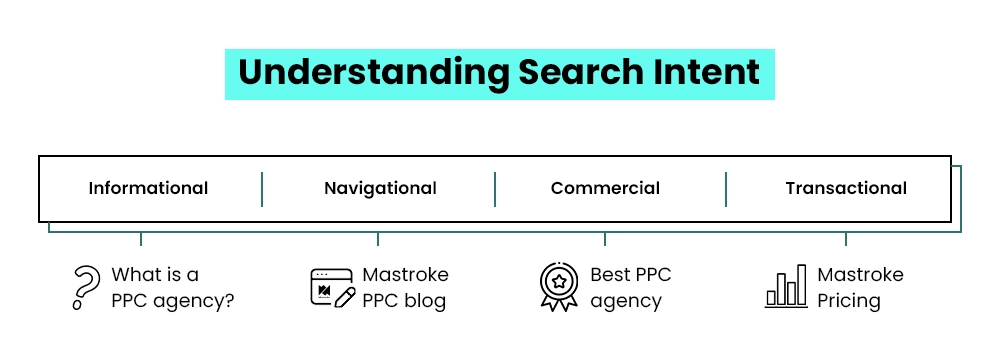
Next, consider search intent: are users seeking information or ready to take action? For example, someone exploring solutions might search “best CRM for small business,” while someone closer to converting might search “HubSpot CRM pricing.”
Don’t overlook your competitors. Analyze their keywords to find keyword gaps—high-performing terms they use that you’re missing. Also, define negative keywords to prevent your ads from showing for irrelevant or low-converting terms.
When creating search ads, set keyword match types:
- Broad match: Triggers ads for variations, synonyms, and related terms.
- Phrase match: Shows ads when searches contain your keyword phrase with slight variations.
- Exact match: Limits ads to searches that exactly match your keyword or close variants.
Smart keyword research is essential to drive traffic and connect with the right users through your PPC campaigns.
3. Choose Your Campaign Type And Channel
Choosing the right platform is a critical step in launching your first PPC campaign. Each advertising channel caters to different audience types, so start by aligning your choice with your target demographic.
For instance, LinkedIn’s professional user base is ideal for B2B services like enterprise software, while TikTok appeals to younger, trend-focused consumers, perfect for fashion or lifestyle brands.
Let’s explore the main PPC platforms:
A) Google Ads- The largest PPC platform, Google Ads, allows advertisers to pay for a search engine results page placement to appear at the top of relevant searches. It supports multiple ad types—search, display, video, shopping—letting you tailor campaigns based on your goals. You can organize your campaign into ad groups for better targeting and optimization.
B) Meta Ads (Facebook & Instagram)- With highly visual ad formats like image, video, carousel, and shoppable posts, Meta Ads Manager is great for B2C brands. Its robust audience targeting based on demographics and interests helps refine your reach.
C) Microsoft Advertising- This platform extends your reach across Bing and Yahoo. While often overlooked, it can deliver strong ROI thanks to less competition and lower costs per click.
D) LinkedIn Ads- Best suited for B2B marketing, LinkedIn lets you target users based on job titles, industries, and professional skills.
E) Other Platforms- YouTube, Twitter, and TikTok offer unique ad experiences and formats for video-driven engagement or viral content.
Choosing the right platform sets the foundation for a successful PPC campaign—one that meets your audience where they are and maximizes your ad spend.
– Also Read- The Ultimate Guide to Google Ads Editor: Everything You Need to Know
4. Set Your Budget
Once you’ve set your PPC goals, the next step is creating a realistic campaign budget. Costs for PPC in marketing can vary widely based on factors like your industry, competition level, and the ad network you choose.
On average, small to mid-sized businesses spend between $15,000 and $20,000 per month on paid search advertising, with a typical cost-per-click (CPC) around $2.59.
To estimate your budget, start by researching industry benchmarks and keyword forecasting data. Look at what other advertisers are spending on similar keywords and check average maximum bids for search queries relevant to your business.
Keep in mind that competitive industries, like legal or financial services, often come with higher CPCs and larger budget requirements.
There are a few ways to determine your PPC budget:
- Use a percentage of projected or previous sales (e.g., 5–10% of annual revenue).
- Base it on historical campaign data or industry norms.
- Factor in additional tools or software ($15–$800/month) and PPC agency fees (typically 12–30% of your ad spend).
A thoughtful budget not only keeps your campaign cost-effective but also ensures your investment delivers measurable results.
5. Describe and Segment Your Audience
Once your ad groups are set, the next step in building a strong PPC campaign is defining and segmenting your audience. Audience segmentation helps you deliver more personalized ads, leading to stronger engagement and better campaign results.
Here are four effective ways to segment your audience for pay-per-click advertising:
- Demographic targeting: Use characteristics like age, gender, income, or job title to tailor messaging that speaks to your audience’s specific needs.
- Location-based targeting: Narrow your focus to specific regions, cities, or neighborhoods—ideal for local businesses or area-specific promotions.
- Device-based targeting: Serve optimized ads based on whether users are browsing on mobile, tablet, or desktop, improving user experience and engagement.
- Time-based targeting (ad scheduling): Run your ads during the hours or days when your audience is most active, increasing the likelihood of clicks and conversions.
Strategic segmentation ensures your PPC ads resonate with the right users at the right time, maximizing your return on ad spend and enhancing campaign performance.
6. Create Your Ads
Now comes the creative part: building your PPC ads. Start by writing compelling ad copy that speaks directly to your target audience’s needs.
Use insights from your keyword research to include high-performing terms; this not only improves ads ranks but also signals that you understand your audience’s pain points.
Be sure to:
- Highlight your unique selling proposition (USP)—what makes your offer stand out.
- Include a clear call-to-action (CTA) like “Get Started,” “Sign Up,” or “Schedule a Demo.”
- Test multiple ad variations with different CTAs for A/B testing to identify the best performers.
Each PPC ad should link to a high-converting landing page. Avoid sending traffic to your homepage. Instead:
- Use a dedicated landing page tailored to the offer in your ad.
- Keep the page clean and focused—remove distracting navigation or outbound links.
- Ensure the CTA on your landing page matches the ad’s CTA for consistency and clarity.
Well-written ads paired with relevant keywords and strong landing pages help boost ads ranks, improve click-through rates, and drive higher conversions in your PPC campaigns.
– Also Read- How to Optimize Your PPC Landing Pages for SEO
7. Analyze, Optimize, & Monitor
The key to long-term success with PPC in marketing is continuous management and optimization. As your campaign runs, use performance data to refine and improve.
Here are essential tips for optimizing your PPC campaign:
- Test bidding strategies: Experiment with automated and manual bidding options to maximize ROI based on your campaign goals.
- Refresh ad copy: Regularly update your headlines and descriptions. A/B test variations to see which messaging drives the highest engagement.
- Leverage ad scheduling: Run your ads only during high-converting times. For example, pause ads during off-hours to avoid wasting budget.
- Refine targeting: Analyze your audience data to uncover trends. Adjust your targeting based on location, device, behavior, or demographics.
- Monitor campaign metrics: Track performance weekly to catch inefficiencies early. Focus on click-through rates, conversion rates, and cost per click (CPC).
By making data-driven adjustments, you ensure your PPC campaign stays aligned with your goals and budget—continuously improving over time.
Common PPC Mistakes to Avoid
Take a look at some of the common mistakes to avoid during PPC campaigns:
1. Ignoring Keyword Research and Negative Keywords
One of the most common and costly PPC mistakes is skipping proper keyword research. Without it, you risk targeting irrelevant terms that exhaust your budget without driving conversions.
Avoid this by:
- Conducting thorough keyword research: Focus on high-intent, relevant keywords that match your audience’s search behavior.
- Using negative keywords: These filter out irrelevant traffic by preventing your ads from showing on unrelated search terms.
For example, if you sell premium software, you might want to exclude searches like “free software.” Ignoring this step can lead to low click-through rates and wasted ad spend.
2. Poor Ad Copy and Weak Calls to Action
Weak ad copy can hurt your PPC performance by failing to grab attention or drive action. If your messaging is unclear or generic, users are less likely to click or convert.
Avoid this by:
- Writing clear, benefit-driven ad copy that speaks directly to your audience’s needs.
- Highlighting your unique selling proposition (USP) to stand out from competitors.
- Using strong, direct calls to action (CTAs) like “Get a Free Trial” or “Schedule a Demo” to guide users.
Your ad should make it obvious what action you want users to take and why it benefits them. Skipping this step results in missed opportunities and lower return on ad spend.
3. Neglecting Landing Page Experience
Driving clicks is only half the battle; what happens after the click matters just as much. Neglecting the landing page experience can lead to high bounce rates and low conversion rates.
To avoid this mistake:
- Ensure the message matches between your ad and landing page to keep user expectations aligned.
- Design clean, fast-loading, and mobile-friendly pages for a smoother user experience.
- Remove distractions like excessive navigation or irrelevant links.
- Include a strong, clear call-to-action (CTA) to guide users to the next step.
An optimized landing page reinforces your ad’s promise and increases the chances of turning clicks into conversions.
4. Not Tracking Conversions or ROI Properly
One of the biggest mistakes in PPC marketing is running campaigns without proper conversion or ROI tracking. Without this data, it’s nearly impossible to measure effectiveness or justify ad spend.
To avoid this error:
- Set up conversion tracking using tools like Google Ads and Google Analytics.
- Define clear goals, whether it’s form submissions, purchases, or demo signups.
- Calculate ROI by comparing revenue generated to ad spend.
- Review performance regularly to make data-driven adjustments.
Tracking conversions and ROI ensures your PPC campaigns are aligned with business goals and helps you identify what’s working and what’s not.
– Also Read- How to Create a Successful PPC Campaign Strategy to Captivate Your Audience
Conclusion
PPC in marketing is a powerful strategy to drive targeted traffic, generate leads, and boost conversions quickly and efficiently. Whether you’re a small business or an enterprise, PPC offers measurable results and flexible budgeting options.
By understanding campaign types, choosing the right platform, researching keywords, and continuously optimizing performance, you can maximize your ROI. Avoiding common pitfalls like weak ad copy, poor targeting, and neglecting conversion tracking will set your campaigns up for long-term success.
As digital competition grows, mastering PPC in marketing is essential for staying visible and competitive in the online landscape. Ready to launch your first campaign? Start with a clear strategy and let data guide your success.
Stay curious, experiment a little, pay attention to the data, or get help from Our Paid Advertising experts at Mastroke if you want sure results.
FAQs-
1. How much should I spend on PPC?
PPC budgets vary, but small to mid-sized businesses typically spend $1,000 to $10,000 monthly. Start with a test budget aligned with your goals, then scale based on performance, ROI, and keyword competition.
2. How long before I see results?
PPC results can be seen within a few days, but optimal performance usually takes 1–3 months. This allows time for testing ad variations, refining targeting, and improving quality scores for better ROI.
3. Are PPC and CPC the same?
PPC (Pay-Per-Click) is a digital advertising model where you pay for each click on your ad. CPC (Cost-Per-Click) is the actual amount you pay per click. So, they’re related but not the same.
4. What is PPC management?
PPC management involves overseeing and optimizing a company’s pay-per-click advertising strategy. It includes keyword research, ad creation, budget allocation, bid management, performance tracking, and ongoing adjustments to improve ROI and campaign effectiveness.
5. Is PPC only used with Google Ads?
No, PPC isn’t limited to Google Ads. It’s also used on platforms like Bing Ads, Facebook, Instagram, LinkedIn, and Amazon. Any platform that allows advertisers to pay per click can support PPC campaigns.